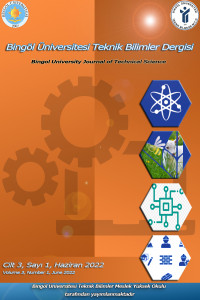İç Mimarlık Eğitimi Kapsamında Detay Tasarımı Öğrenci Stüdyo Çalışmalarına Yönelik Bir Değerlendirme
Abstract
Detay tasarımı, mimari tasarım sürecinin uygulama aşamasını kurgulamaktadır. Uygulamanın kurgulanması ise mimari tasarım sürecinin sağlıklı şekilde tamamlanabilmesi için gereklidir. Bu önemi nedeniyle mimari tasarım eğitimi verilen mimarlık ve iç mimarlık bölümlerinde detay tasarımı konusu öncelikli olarak görülmektedir. Çalışma kapsamında bu konudaki anlayışın altyapısını oluşturan ve temel alınan hipoteze göre, detayların uyarlanabilir olması yapının tasarım, üretim ve kullanım süreçlerinin yönetilebilirliğini artırmaktadır. Bu temelde, Çukurova Üniversitesi İç Mimarlık bölümü Malzeme ve Yapı İçi Konstrüksiyon-5 dersi kapsamında karşılaştırmalı bir süreç yürütülmüştür. Dönem içerisinde öğrencilere mimari detayın çağrıştırdıklarını, iki ve üç boyutlu olarak ifade etmeleri istenmiştir. Süreçte öğrencilerin detay çözümlemesine dair ilk bakışları ve detay tasarım hipotezi aktarımından sonrasındaki yaklaşımları karşılaştırılmıştır. Bu kapsamda öğrencilerin kullandıkları bağlantı yöntemleri ve uyarlanabilir detayları oluşturabilme potansiyeli ölçekli detay maket çalışmaları üzerinden değerlendirilmiştir. Bu değerlendirmeden elde edilen sonuçlara göre detay tasarımı ve mimari tasarım eğitimi ilişkisine yönelik öneriler sunulmuştur.
References
- [1] Deniz, Ö.Ş. (2019). Yapı Elemanlarının Detay Tasarımı İçin Bir Tasarım-Karar Verme Modeli A Design-Decision Making Model for Detail Design of Building Elements. MEGARON 2019;14(4):623-648 DOI: 10.14744/MEGARON.2019.53486
- [2] Ekholm, A., & Häggström, L. (2011). Building classification for BIM – Reconsidering the framework. Proceedings of the CIB W078-W102: 2011 Joint International Conference. Sophia Antipolis, France; 26-28 October. Retrieved from http://2011-cibw078-w102.cstb.fr/papers/Paper-20.pdf
- [3] Afsari K. and Eastman, C. (2016) “A Comparison of Construction Classification Systems Used for Classifying Building Product Models”, Proceedings of 52nd Annual International Conference of the Associated Schools of Construction. Provo, Utah, April 13-16, 2016.
- [4] Nicholas, C., & Oak, A. (2020). Make and break details: The architecture of design-build education. Design Studies, 66, 35–53. https://doi.org/10.1016/j.destud.2019.12.003
- [5] Durmisevic, E. (2006) Transformable Building Structures, Cedris M&CC, Netherlands.
- [6] Morgan, C., Stevenson, F. (2005) Design and Detailing for Deconstruction, SEDA Design Guides for Scotland: No. 1,: Scottish Ecological Design Association (SEDA), Edinburgh, Scotland.
- [7] Guy, B., Ciarimboli, N. (2007), DFD Design for Disassembly in the Built Environment: A Guide to Closed-Loop Design and Building, Hamer Center for Community Design, Pennsylvania State University, USA.
- [8] Kibert, C. (1994) Establishing Principle And a Model For Sustainable Construction, CIB TG 16, Sustainable Construction, Tampa Florida, USA.
- [9] Crowther, P. (2001), Developing an Inclusive Model for Design for Deconstruction. CIB Task Group 39- Deconstruction, Annual Meeting, Wellington, New Zealand.
- [10] Kılıç, O. (2019), Tasarım-Uygulama Birlikteliğinin Kurgulanmasında Uyarlanabilirliği Sağlayan Mimari Detay Tasarımına Yönelik Bir Analiz Yöntemi, Sanatta Yeterlik Tezi, Çukurova Üniversitesi, Sosyal Bilimler Enstitüsü, Adana.
An Evaluation of Detail Design Student Studio Studies within the Scope of Interior Architecture Education
Abstract
Detail design constructs the application phase of the architectural design process. The construction of the application is necessary for the successful completion of the architectural design process. Due to this importance, the subject of detail design is seen as a priority in the architecture and interior architecture departments where architectural design education is given. According to the hypothesis, which forms the basis of the understanding on this subject within the scope of the study and is based on, the adaptability of the details increases the manageability of the design, production and use processes of the structure. On this basis, a comparative process was carried out within the scope of Cukurova University Interior Architecture Department Materials and Interior Construction-5 course. During the term, students were asked to express what the architectural detail evokes in two and three dimensions. In the process, students' first views on detail analysis and their approaches after transferring the detail design hypothesis were compared. In this context, the connection methods used by the students and the potential to create adaptive details were evaluated through scaled detail model studies. According to the results obtained from this evaluation, suggestions for the relationship between detail design and architectural design education are presented.
Keywords
Architectural design education Detail design Connection methods Adaptibility Disassembility
References
- [1] Deniz, Ö.Ş. (2019). Yapı Elemanlarının Detay Tasarımı İçin Bir Tasarım-Karar Verme Modeli A Design-Decision Making Model for Detail Design of Building Elements. MEGARON 2019;14(4):623-648 DOI: 10.14744/MEGARON.2019.53486
- [2] Ekholm, A., & Häggström, L. (2011). Building classification for BIM – Reconsidering the framework. Proceedings of the CIB W078-W102: 2011 Joint International Conference. Sophia Antipolis, France; 26-28 October. Retrieved from http://2011-cibw078-w102.cstb.fr/papers/Paper-20.pdf
- [3] Afsari K. and Eastman, C. (2016) “A Comparison of Construction Classification Systems Used for Classifying Building Product Models”, Proceedings of 52nd Annual International Conference of the Associated Schools of Construction. Provo, Utah, April 13-16, 2016.
- [4] Nicholas, C., & Oak, A. (2020). Make and break details: The architecture of design-build education. Design Studies, 66, 35–53. https://doi.org/10.1016/j.destud.2019.12.003
- [5] Durmisevic, E. (2006) Transformable Building Structures, Cedris M&CC, Netherlands.
- [6] Morgan, C., Stevenson, F. (2005) Design and Detailing for Deconstruction, SEDA Design Guides for Scotland: No. 1,: Scottish Ecological Design Association (SEDA), Edinburgh, Scotland.
- [7] Guy, B., Ciarimboli, N. (2007), DFD Design for Disassembly in the Built Environment: A Guide to Closed-Loop Design and Building, Hamer Center for Community Design, Pennsylvania State University, USA.
- [8] Kibert, C. (1994) Establishing Principle And a Model For Sustainable Construction, CIB TG 16, Sustainable Construction, Tampa Florida, USA.
- [9] Crowther, P. (2001), Developing an Inclusive Model for Design for Deconstruction. CIB Task Group 39- Deconstruction, Annual Meeting, Wellington, New Zealand.
- [10] Kılıç, O. (2019), Tasarım-Uygulama Birlikteliğinin Kurgulanmasında Uyarlanabilirliği Sağlayan Mimari Detay Tasarımına Yönelik Bir Analiz Yöntemi, Sanatta Yeterlik Tezi, Çukurova Üniversitesi, Sosyal Bilimler Enstitüsü, Adana.
Details
| Primary Language | Turkish |
|---|---|
| Subjects | Architectural Design |
| Journal Section | Research Articles |
| Authors | |
| Early Pub Date | June 25, 2022 |
| Publication Date | June 30, 2022 |
| Submission Date | April 1, 2022 |
| Published in Issue | Year 2022 Volume: 3 Issue: 1 |
This journal is prepared and published by the Bingöl University Technical Sciences journal team.

